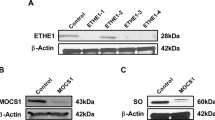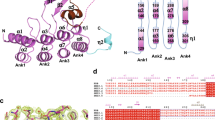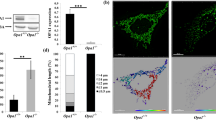Abstract
Mitochondrial dysfunction and oxidative stress are central to the molecular basis of several human diseases associated with neuromuscular disabilities. We hypothesize that mitochondrial dysfunction also contributes to the neuromuscular symptoms observed in patients with ethylmalonic aciduria and homozygosity for ACADS c.625G>A-a common variant of the short-chain acyl-coenzyme A (CoA) dehydrogenase (SCAD) enzyme in the mitochondrial fatty acid oxidation pathway. This study sought to identify the specific factors that initiate cell dysfunction in these patients. We investigated fibroblast cultures from 10 patients with neuromuscular disabilities, elevated levels of ethylmalonic acid (EMA) (>50 mmol/mol creatinine), and ACADS c.625G>A homozygosity. Functional analyses, i.e., ACADS gene and protein expression as well as SCAD enzyme activity measurements, were performed together with a global nano liquid chromatography tandem mass spectroscopy (nano-LC-MS/MS)-based screening of the mitochondrial proteome in patient fibroblasts. Moreover, cell viability of patient fibroblasts exposed to menadione-induced oxidative stress was evaluated. Loss of SCAD function was detected in the patient group, most likely due to decreased ACADS gene expression and/or elimination of misfolded SCAD protein. Analysis of the mitochondrial proteome in patient fibroblasts identified a number of differentially expressed protein candidates, including reduced expression of the antioxidant superoxide dismutase 2 (SOD2). Additionally, patient fibroblasts demonstrated significantly higher sensitivity to oxidative stress than control fibroblasts. We propose that reduced mitochondrial antioxidant capacity is a potential risk factor for ACADS c.625G>A-associated ethylmalonic aciduria and that mitochondrial dysfunction contributes to the neurotoxicity observed in patients.







Similar content being viewed by others
Abbreviations
- FCS:
-
Fetal calf serum
- EMA:
-
Ethylmalonic acid
- FAD:
-
Flavin adenine dinucleotide
- SCAD:
-
Short-chain acyl-CoA dehydrogenase
- SOD2:
-
Superoxide dismutase 2
- PPAR:
-
Peroxisome proliferator activated receptor
- ETF:
-
Electron transfer flavoprotein
References
Bok LA, Vreken P, Wijburg FA, Wanders RJ, Gregersen N, Corydon MJ, Waterham HR, Duran M (2003) Short-chain acyl-CoA dehydrogenase deficiency: studies in a large family adding to the complexity of the disorder. Pediatrics 112:1152–1155
Burlina AB, onisi-Vici C, Bennett MJ, Gibson KM, Servidei S, Bertini E, Hale DE, Schmidt-Sommerfeld E, Sabetta G, Zacchello F (1994) A new syndrome with ethylmalonic aciduria and normal fatty acid oxidation in fibroblasts. J Pediatr 124:79–86
Christensen E, Brandt NJ, Schmalbruch H, Kamieniecka Z, Hertz B, Ruitenbeek W (1993) Muscle cytochrome c oxidase deficiency accompanied by a urinary organic acid pattern mimicking multiple acyl-CoA dehydrogenase deficiency. J Inherit Metab Dis 16:553–556
Coates PM, Hale DE, Finocchiaro G, Tanaka K, Winter SC (1988) Genetic deficiency of short-chain acyl-coenzyme A dehydrogenase in cultured fibroblasts from a patient with muscle carnitine deficiency and severe skeletal muscle weakness. J Clin Invest 81:171–175
Corydon MJ, Gregersen N, Lehnert W, Ribes A, Rinaldo P, Kmoch S, Christensen E, Kristensen TJ, Andresen BS, Bross P, Winter V, Martinez G, Neve S, Jensen TG, Bolund L, Kolvraa S (1996) Ethylmalonic aciduria is associated with an amino acid variant of short chain acyl-coenzyme A dehydrogenase. Pediatr Res 39:1059–1066
Corydon MJ, Andresen BS, Bross P, Kjeldsen M, Andreasen PH, Eiberg H, Kolvraa S, Gregersen N (1997) Structural organization of the human short-chain acyl-CoA dehydrogenase gene. Mamm Genome 8:922–926
Corydon TJ, Bross P, Jensen TG, Corydon MJ, Lund TB, Jensen UB, Kim JJ, Gregersen N, Bolund L (1998) Rapid degradation of short-chain acyl-CoA dehydrogenase variants with temperature-sensitive folding defects occurs after import into mitochondria. J Biol Chem 273:13065–13071
Cox J, Mann M (2008) MaxQuant enables high peptide identification rates, individualized p.p.b.-range mass accuracies and proteome-wide protein quantification. Nat Biotechnol 26:1367–1372
Ding G, Fu M, Qin Q, Lewis W, Kim HW, Fukai T, Bacanamwo M, Chen YE, Schneider MD, Mangelsdorf DJ, Evans RM, Yang Q (2007) Cardiac peroxisome proliferator-activated receptor gamma is essential in protecting cardiomyocytes from oxidative damage. Cardiovasc Res 76:269–279
Djouadi F, Bastin J (2008) PPARs as therapeutic targets for correction of inborn mitochondrial fatty acid oxidation disorders. J Inherit Metab Dis 31:217–225
Froyland E, Wibrand F, Almaas R, Dalen I, Lindstad JK, Rootwelt T (2005) Acidosis during reoxygenation has an early detrimental effect on neuronal metabolic activity. Pediatr Res 57:488–493
Gregersen N (1985) Riboflavin-responsive defects of beta-oxidation. J Inherit Metab Dis 8(Suppl 1):65–69
Gregersen N, Winter VS, Corydon MJ, Corydon TJ, Rinaldo P, Ribes A, Martinez G, Bennett MJ, Vianey-Saban C, Bhala A, Hale DE, Lehnert W, Kmoch S, Roig M, Riudor E, Eiberg H, Andresen BS, Bross P, Bolund LA, Kolvraa S (1998) Identification of four new mutations in the short-chain acyl-CoA dehydrogenase (SCAD) gene in two patients: one of the variant alleles, 511C->T, is present at an unexpectedly high frequency in the general population, as was the case for 625G->A, together conferring susceptibility to ethylmalonic aciduria. Hum Mol Genet 7:619–627
Gregersen N, Andresen BS, Pedersen CB, Olsen RK, Corydon TJ, Bross P (2008) Mitochondrial fatty acid oxidation defects-remaining challenges. J Inherit Metab Dis 31:643–657
Hansen J, Corydon TJ, Palmfeldt J, Durr A, Fontaine B, Nielsen MN, Christensen JH, Gregersen N, Bross P (2008) Decreased expression of the mitochondrial matrix proteases Lon and ClpP in cells from a patient with hereditary spastic paraplegia (SPG13). Neuroscience 153:474–482
Hegre CS, Halenz DR, Lane MD (1959) The enzymatic carboxylation of butyryl coenzyme A. J Am Chem Soc 84:6526–6527
Hoffmann GF, Hunneman DH, Jakobs C, Wilichowski E, Eber SW, Hanefeld F, Rating D, Reichmann H (1990) Progressive fatal pancytopenia, psychomotor retardation and muscle carnitine deficiency in a child with ethylmalonic aciduria and ethylmalonic acidaemia. J Inherit Metab Dis 13:337–340
Ikeda Y, Okamura-Ikeda K, Tanaka K (1985) Purification and characterization of short-chain, medium-chain, and long-chain acyl-CoA dehydrogenases from rat liver mitochondria. Isolation of the holo-and apoenzymes and conversion of the apoenzyme to the holoenzyme. J Biol Chem 260:1311–1325
Jorgensen MM, Jensen ON, Holst HU, Hansen JJ, Corydon TJ, Bross P, Bolund L, Gregersen N (2000) Grp78 is involved in retention of mutant low density lipoprotein receptor protein in the endoplasmic reticulum. J Biol Chem 275:33861–33868
Lee YH, Boelsterli UA, Lin Q, Chung MC (2008) Proteomics profiling of hepatic mitochondria in heterozygous Sod2+/-mice, an animal model of discreet mitochondrial oxidative stress. Proteomics 8:555–568
Lehnert W, Ruitenbeek W (1993) Ethylmalonic aciduria associated with progressive neurological disease and partial cytochrome c oxidase deficiency. J Inherit Metab Dis 16:557–559
Li M, Chiu JF, Mossman BT, Fukagawa NK (2006) Down-regulation of manganese-superoxide dismutase through phosphorylation of FOXO3a by Akt in explanted vascular smooth muscle cells from old rats. J Biol Chem 281:40429–40439
MacMillan-Crow LA, Cruthirds DL (2001) Invited review: manganese superoxide dismutase in disease. Free Radic Res 34:325–336
Melov S, Coskun P, Patel M, Tuinstra R, Cottrell B, Jun AS, Zastawny TH, Dizdaroglu M, Goodman SI, Huang TT, Miziorko H, Epstein CJ, Wallace DC (1999) Mitochondrial disease in superoxide dismutase 2 mutant mice. Proc Natl Acad Sci USA 96:846–851
Miao L, St Clair DK (2009) Regulation of superoxide dismutase genes: implications in disease. Free Radic Biol Med 47:344–356
Nagan N, Kruckeberg KE, Tauscher AL, Bailey KS, Rinaldo P, Matern D (2003) The frequency of short-chain acyl-CoA dehydrogenase gene variants in the US population and correlation with the C(4)-acylcarnitine concentration in newborn blood spots. Mol Genet Metab 78:239–246
Nguyen TV, Riggs C, Babovic-Vuksanovic D, Kim YS, Carpenter JF, Burghardt TP, Gregersen N, Vockley J (2002) Purification and characterization of two polymorphic variants of short chain acyl-CoA dehydrogenase reveal reduction of catalytic activity and stability of the Gly185Ser enzyme. Biochemistry 41:11126–11133
Olmos Y, Valle I, Borniquel S, Tierrez A, Soria E, Lamas S, Monsalve M (2009) Mutual dependence of Foxo3a and PGC-1alpha in the induction of oxidative stress genes. J Biol Chem 284:14476–14484
Pagliarini DJ, Calvo SE, Chang B, Sheth SA, Vafai SB, Ong SE, Walford GA, Sugiana C, Boneh A, Chen WK, Hill DE, Vidal M, Evans JG, Thorburn DR, Carr SA, Mootha VK (2008) A mitochondrial protein compendium elucidates complex I disease biology. Cell 134:112–123
Palmfeldt J, Vang S, Stenbroen V, Pedersen CB, Christensen JH, Bross P, Gregersen N (2009) Mitochondrial proteomics on human fibroblasts for identification of metabolic imbalance and cellular stress. Proteome Sci 7:20
Pedersen CB, Bross P, Winter VS, Corydon TJ, Bolund L, Bartlett K, Vockley J, Gregersen N (2003) Misfolding, degradation, and aggregation of variant proteins. The molecular pathogenesis of short chain acyl-CoA dehydrogenase (SCAD) deficiency. J Biol Chem 278:47449–47458
Pedersen CB, Kolvraa S, Kolvraa A, Stenbroen V, Kjeldsen M, Ensenauer R, Tein I, Matern D, Rinaldo P, Vianey-Saban C, Ribes A, Lehnert W, Christensen E, Corydon TJ, Andresen BS, Vang S, Bolund L, Vockley J, Bross P, Gregersen N (2008) The ACADS gene variation spectrum in 114 patients with short-chain acyl-CoA dehydrogenase (SCAD) deficiency is dominated by missense variations leading to protein misfolding at the cellular level. Hum Genet 124:43–56
Rhead WJ, Wolff JA, Lipson M, Falace P, Desai N, Fritchman K, Moon A, Sweetman L (1987) Clinical and biochemical variation and family studies in the multiple acyl-CoA dehydrogenation disorders. Pediatr Res 21:371–376
Rinaldo P, Welch RD, Previs SF, Schmidt-Sommerfeld E, Gargus JJ, O’Shea JJ, Zinn AB (1991) Ethylmalonic/adipic aciduria: effects of oral medium-chain triglycerides, carnitine, and glycine on urinary excretion of organic acids, acylcarnitines, and acylglycines. Pediatr Res 30:216–221
Tiranti V, D’Adamo P, Briem E, Ferrari G, Mineri R, Lamantea E, Mandel H, Balestri P, Garcia-Silva MT, Vollmer B, Rinaldo P, Hahn SH, Leonard J, Rahman S, onisi-Vici C, Garavaglia B, Gasparini P, Zeviani M (2004) Ethylmalonic encephalopathy is caused by mutations in ETHE1, a gene encoding a mitochondrial matrix protein. Am J Hum Genet 74:239–252
Tiranti V, Briem E, Lamantea E, Mineri R, Papaleo E, Degioia L, Forlani F, Rinaldo P, Dickson P, bu-Libdeh B, Cindro-Heberle L, Owaidha M, Jack RM, Christensen E, Burlina A, Zeviani M (2005) ETHE1 mutations are specific to Ethylmalonic Encephalopathy. J Med Genet 43:340–346
Tiranti V, Viscomi C, Hildebrandt T, Di MI, Mineri R, Tiveron C, Levitt MD, Prelle A, Fagiolari G, Rimoldi M, Zeviani M (2009) Loss of ETHE1, a mitochondrial dioxygenase, causes fatal sulfide toxicity in ethylmalonic encephalopathy. Nat Med 15:200–205
van Maldegem BT, Waterham HR, Duran M, van D V, van Woerden CS, Bobu LL, Wanders RJ, Wijburg FA (2005) The 625G>A SCAD gene variant is common but not associated with increased C4-carnitine in newborn blood spots. J Inherit Metab Dis 28:557–562
van Maldegem BT, Duran M, Wanders RJ, Niezen-Koning KE, Hogeveen M, Ijlst L, Waterham HR, Wijburg FA (2006) Clinical, biochemical, and genetic heterogeneity in short-chain acyl-coenzyme A dehydrogenase deficiency. JAMA 296:943–952
Vega RB, Huss JM, Kelly DP (2000) The coactivator PGC-1 cooperates with peroxisome proliferator-activated receptor alpha in transcriptional control of nuclear genes encoding mitochondrial fatty acid oxidation enzymes. Mol Cell Biol 20:1868–1876
Voloboueva LA, Duan M, Ouyang Y, Emery JF, Stoy C, Giffard RG (2008) Overexpression of mitochondrial Hsp70/Hsp75 protects astrocytes against ischemic injury in vitro. J Cereb Blood Flow Metab 28:1009–1016
Wajner M, Latini A, Wyse AT, Dutra-Filho CS (2004) The role of oxidative damage in the neuropathology of organic acidurias: insights from animal studies. J Inherit Metab Dis 27:427–448
Wanders RJ, Ruiter JP, Wijburg FA (1993) Studies on mitochondrial oxidative phosphorylation in permeabilized human skin fibroblasts: application to mitochondrial encephalomyopathies. Biochim Biophys Acta 1181:219–222
Wanders RJ, Vreken P, den Boer ME, Wijburg FA, van Gennip AH, Ijlst L (1999) Disorders of mitochondrial fatty acyl-CoA beta-oxidation. J Inherit Metab Dis 22:442–487
Yang NC, Ho WM, Chen YH, Hu ML (2002) A convenient one-step extraction of cellular ATP using boiling water for the luciferin-luciferase assay of ATP. Anal Biochem 306:323–327
Young SP, Matern D, Gregersen N, Stevens RD, Bali D, Liu HM, Koeberl DD, Millington DS (2003) A comparison of in vitro acylcarnitine profiling methods for the diagnosis of classical and variant short chain acyl-CoA dehydrogenase deficiency. Clin Chim Acta 337:103–113
Zeevalk GD, Bernard LP, Song C, Gluck M, Ehrhart J (2005) Mitochondrial inhibition and oxidative stress: reciprocating players in neurodegeneration. Antioxid Redox Signal 7:1117–1139
Zhong N, Xu J (2008) Synergistic activation of the human MnSOD promoter by DJ-1 and PGC-1alpha: regulation by SUMOylation and oxidation. Hum Mol Genet 17:3357–3367
Acknowledgement
We thank all the clinicians and researchers from clinical departments around the world for providing DNA and cultured skin fibroblasts from patients and controls (Mike Gibson, OR, USA; Jerry Vockley, Pittsburgh, PA, USA; Orly Elpeleg, Jerusalem, Israel; Mary G. Ampola, Boston, MA, USA; Antonia Ribes, Barcelona, Spain; Dieter Matern, Rochester, NY, USA; Rhona Jack, Seattle, WA, USA; Tarja Linnankivi, Helsinki, Finland; Ina Knerr, Erlangen, Germany; Charles Roe, Dallas, TX, USA; Stanley Korman, Jerusalem, Israel; Sarah P. Young and David S. Millington, NC, USA). We also thank Christian Knudsen at the Department of Human Genetics for assisting with the cell culturing, and Dr. Kay Tanaka for providing the anti-SCAD antibodies. The work was supported by grants from the Danish Medical Research Council and Lundbeck Foundation, Denmark, as well as from a grant from the Physicians’ Services Incorporated Foundation of Ontario, Canada.
Author information
Authors and Affiliations
Corresponding author
Additional information
Communicated by: Matthias Baumgartner
References to electronic databases: Acyl-CoA Dehydrogenase, Short-chain, deficiency of: OMIM 201470; Ethylmalonic encephalopathy: OMIM 602473
Competing interest: None declared.
Rights and permissions
About this article
Cite this article
Pedersen, C.B., Zolkipli, Z., Vang, S. et al. Antioxidant dysfunction: potential risk for neurotoxicity in ethylmalonic aciduria. J Inherit Metab Dis 33, 211–222 (2010). https://doi.org/10.1007/s10545-010-9086-6
Received:
Revised:
Accepted:
Published:
Issue Date:
DOI: https://doi.org/10.1007/s10545-010-9086-6




